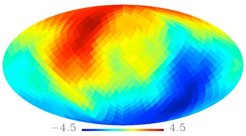Cosmic Microwave Background Radiation might not be a Gaussian random field

Copyright: C.Räth/MPE
Map of one of the statistics used to probe for non-Gaussianities in the WMAP data. The colour coding in the map for the largest scales shows clearly highly significant signatures for non-Gaussianities and asymmetries. Further independent investigations will reveal whether a cosmological origin of the signatures is confirmed.
Copyright: C.Räth/MPE
The Cosmic Microwave Background Radiation (CMB) is the oldest observable signal in the Universe, emitted just 380 000 years after the Big Bang, when the cosmos became transparent. It is therefore an important probe of the very early Universe and has already yielded very precise measurements of the age, geometry and matter and energy content of the Universe. In the analysis of the CMB, it is usually assumed that the small temperature fluctuations are distributed randomly in a Gaussian field. If this is the case, then the analysis can be based on the so-called "power spectrum" of the distribution, which describes the amount of fluctuations seen on different scales - all information about any higher-order correlations is not considered.
These non-Gaussianities, however, contain important information about a process in the very early Universe called "inflation", when the Universe experienced extremely rapid expansion just tiny fractions of a second after the Big Bang. While some inflationary scenarios predict that the fluctuations are nearly Gaussian, more complex models predict deviations from a Gaussian field.
A new method to test for and quantify these non-Gaussiantities was therefore adapted to the CMB analysis by Christoph Räth and his team at the Max Planck Institute for Extraterrestrial Physics. "We are using a statistical analysis called 'surrogate maps' that is already well known in other areas that have to deal with highly complex, non-linear processes, such as climate or stock-market," Räth explains. As in the normal CMB analysis a power spectrum is created out of the real data and then used as input to create "surrogate maps" by assuming random, Gaussian phase correlations. Suitable statistics are then used to compare the original data with these surrogate maps and to find any higher-order correlations.
"We obtain highly significant signatures for non-Gaussianities and asymmetries at the largest scales, the first time that non-Gaussianities have been detected with such a high significance," says Räth. "Various checks on systematics so far did not yield any explanation for this, so we have to assume that this is a cosmological signal."
For their analysis the scientists used several different combinations of the WMAP data collected over 5 or 7 years, including or leaving out certain corrections for foreground radiation to check for systematics. While some signatures found at smaller scales might be introduced by the map making procedure, the significance of the results for large scales increases if the map becomes cleaner. While the scientists will continue their tests with the WMAP data, they will also apply this analysis to new, currently on-going observations of the CMB with Planck satellite, once the data become available. As this is a completely different instrument with independent systematics, this will be the ultimate test for the results obtained for far with this new method.
